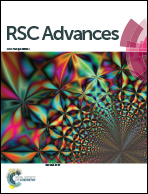A catalytic route to dibenzodiazepines involving Buchwald–Hartwig coupling: reaction scope and mechanistic consideration†
Abstract
We report a new synthetic method for the synthesis of a family of dibenzodiazepines (DBDAs), employing Pd-catalyzed C–N coupling of o-bromoaldimine, with o-bromoaniline as the key step. Eleven DBDAs were prepared, containing electron-withdrawing groups (CN, F, NO2) and electron-donating groups (OMe). The reaction conditions were optimized (catalyst, phosphine, base and solvent) and best results were obtained with Pd(OAc)2, SPhos, Cs2CO3 in THF. Due to the ambiguity of the mechanism at hand, various mechanistic studies were performed, that included DFT calculations. The oxidative addition process was studied in detail by DFT, and these studies supported the observed reaction regioselectivity. The adducts formed between the aldimine and the Pd(0) catalyst were calculated to be more stable than the ones formed with the amine, and the barrier for the oxidative addition at the C–Br bond of the aldimine was calculated to be lower than the one at the C–Br bond of the aryl amine. The formation of DBDA over the dibenzoaminopiperidine has been explained in the final cyclization step.


 Please wait while we load your content...
Please wait while we load your content...